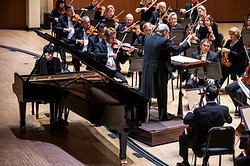By William E Ford, 04 October 2019
There have been 90 days of above 90 degrees (F) in Atlanta, even into early October. It seems that one's sole quest is to move from one air-conditioned space to another, as quickly as possible. Last evening the chillers were working overtime in Symphony Hall; they had to because the Atlanta Symphony Orchestra, under music director Robert Spano, gave a red-hot performance.
Tengku Irfan and Robert Spano © Nunnally Rawson
Tengku Irfan and Robert Spano
© Nunnally Rawson
This is the second concert weekend that began with works of Richard Wagner. The Preludes to Act 1 and 3 from Lohengrin are fine examples of the composer’s romanticism, the first being particularly rich and beautiful, full of mystical lyricism. The introductory passages are played by the high strings, and rather than lush and transparent, the violins sounded rather steely and hard. As the piece progressed their sound became richer and sweeter. The Act 3 Prelude provided an opportunity for the horns to shine, and indeed they did; their confidence and accuracy added to the power of the performance. Maestro Spano chose a brisk tempo that entirely suited.
Béla Bartók is one of the towering figures of 20th-century composers. His style has influenced others, especially those who write for horror or suspense films. He was a master at composing what might be characterized as dark and anxious music. His Second Piano Concerto is one of the most technically demanding in the literature. The music often employs the solo piano as a seven-octave percussion instrument. It requires the pianist to have strength and stamina, as well as an excellent technique. The soloist for this performance was the 20-year old Malaysian pianist Tengku Irfan. He played the first movement, which requires fast, loud, and repeated percussive strikes of the keys, with high energy; the balance between the piano and orchestra was remarkable. The second movement features a slow-fast-slow structure that features Bartók’s signature “night music” style. The second slow section is a somber, dark affair that Irfan’s performance captured with a suitable mystery. The final movement is a high energy whirlwind that engages all sections of the orchestra, while still requiring a strong solo piano. The Irfan/Spano/ASO team showed its mastery of this difficult music to provide a grand performance.
Sometimes, a palate-cleansing is needed – even the hottest of great music can wear out its welcome from too-frequent hearing. Such is the case for Brahms’ symphonies; great though they are, they are over-scheduled in most concert halls. Yet, Brahms Symphony no. 1 in C minor has not been played in Atlanta for three seasons. This seemed just long enough to again hear the music with “fresh ears”. And what were those ears greeted with? A white-hot performance of this mighty work that showcased once again, that given the right music, the ASO under Spano can deliver a performance that is truly memorable. From the incessant introductory beats at the beginning to the finale’s brass, the orchestra was at its best. Brahms plays to the ASO’s strengths. He pairs the woodwinds (especially the brilliant ASO oboe and clarinet and the horns, which played with great precision and warmth). The solo violin of Concertmaster David Coucheron was gentle yet soaring; the trombones and low brass were as good as one could expect. The low strings helped ground the music, but also provided needed warmth, especially in the grand melody of the final movement. The only nit-pick criticism was that the third movement began with slight and short-lived ensemble problems. This was a fervent and thrilling performance that reminds why this symphony is so well-loved.
*****

 Back to List
Back to List